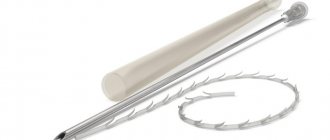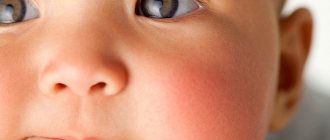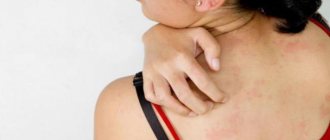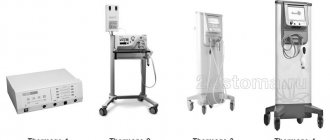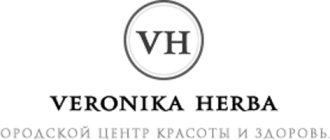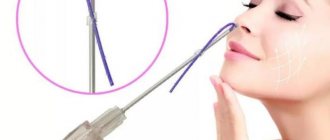From this article you will learn:
- what is thread lifting,
- how effective are mesothreads for face lifting – patient reviews,
- 2D and 3D mesothreads – reviews from doctors, before and after photos.
Mesothreads are a low-traumatic skin lifting method that was developed in 2011 by a South Korean company specializing in the production of the finest acupuncture needles. This origin is not accidental, because Initially, mesothreads were invented for installation deep into tissues in the projection of acupuncture points in order to achieve long-term stimulation of nerve endings. The procedure for introducing mesothreads into tissue is called thread lifting (from the English Thread - thread).
Mesothreads (synonym - biostimulating threads) are only one of several thread options used in thread implantology, and not the most effective. But their installation is quite simple and does not require too high qualifications from a cosmetologist, which, together with their low cost, makes them a mass commercial product. Other types of threads include the so-called - 1) reinforcing, 2) lifting, 3) shaping threads.
Mesothreads: photo
Most mesothreads are made by manufacturers from the material “polydioxanone” (PDO). Threads made from this material begin to fragment in tissues after just 1 month, and their complete destruction takes about 4-6 months. Threads are introduced under the skin according to special patterns and create a kind of frame around which new collagen will be produced in the skin and wrinkles will be smoothed out (Fig. 2-3). But all this looks good only in theory, and if they tell you about pronounced lifting with mesothreads, which will last almost 1 year, then know that all this is not true.
The author of this article is a practicing surgeon/cosmetologist and has a certificate in thread lifting. Everything written in this article is not only a personal opinion, but also the generalized experience of colleagues who are opinion leaders in the field of thread lifting in Russia (for example, Gruzdev, Sulamanidze, Fedorov, Alexandrov, Kodyakov, etc.). In this article we will analyze the different types of mesothreads and their indications, and also talk about the real possibilities of using mesothreads in aesthetic cosmetology.
3D mesothreads for face lift: indications
On the websites of cosmetic clinics, the indications for a facelift with mesothreads look very beautiful, but more often than not, everything that is written there is usually not true. The purpose of such advertising articles is to encourage the patient to buy a completely affordable thread lifting procedure using mesothreads. The promise of the impossible is precisely the reason why most patients’ reviews on mesothreads later turn out to be negative. Advertising tells us that thread lifting with mesothreads is intended for:
- improving the appearance and elasticity of the skin,
- correction of wrinkles on the forehead,
- brow lifts,
- tightening the area around the eyes,
- smoothing wrinkles and folds,
- improving the shape of the oval face and submandibular area.
Additional effects when used on the body include tightening of loose tissue in the chest area, buttocks, abdomen, arms and legs, as well as for eliminating unevenness and sagging skin after liposuction or pregnancy. But in fact, mesothreads (synonym - biostimulating threads) are intended only - 1) for the prevention of age-related skin changes, 2) as the first stage of thread lifting in patients with loose skin, in order to strengthen the skin before installing more serious types of threads - reinforcing or lifting.
And thirdly (with regard to the correction of changes that have already occurred), mesothreads in some cases can improve the appearance of the skin and slightly increase its elasticity. The effect of the procedure will be noticeable only in patients with a finely wrinkled type of aging, who have thin skin, and which should be in poor condition. If you have relatively well-groomed skin, then you most likely will not notice the effect at all. Also, you most likely will not notice any effect from the procedure if you have thick skin or soft tissue ptosis.
As for the effect of smoothing out wrinkles, you shouldn’t really count on this when using mesothreads. Of course, immediately after the procedure, the cosmetologist will take you to the mirror and show you the changes. Some changes can actually be noticeable immediately after the procedure - due to swelling, which increases the volume of the tissue, smoothing out wrinkles. That is why, when for advertising purposes they show photos before and after installing mesothreads, the “after photo” is almost always taken immediately after the procedure, when tissue swelling is still present and there is a characteristic blush (redness). If you need a lifting effect, then you need not meso-, but lifting or reinforcing threads.
Who is suitable for installing American threads?
- people who notice the first signs of sagging skin, nasolabial folds, contouring of the eye sockets.
- for those who want to “ennoble” rough facial lines.
- People who want to avoid facelift surgery are concerned about long recovery times and pain.
- for those who want to give their face youthful features, but get the result literally “tomorrow” in order to quickly return to everyday life.
- for everyone who is afraid of scars: the threads are installed through punctures in the skin and do not require incisions.
- anyone who wants to quickly improve their facial contour and straighten their lower jaw line, giving it the shape of an English letter V.
- for those who want to undergo surgical face lifting and maintain the achieved results for several years longer.
Important: chemical composition of mesothreads
As we said above, at the moment almost all Korean, Russian and European manufacturers of mesothreads make them from the inexpensive surgical suture material “polydioxanone” (PDO). This choice is explained by the high biological compatibility of this material, but most importantly, by its extremely low cost. Threads made from PDO are destroyed faster in tissues than threads made from any other materials, and to slow down this process, some manufacturers apply gold plating or a layer of polyglycolic acid (PGA) to the surface of PDO mesothreads.
The second option is threads made from pure caprolactone (PLC), but like polydioxanone, this material also has only minimal biostimulating effects. The third option includes threads made of caprolactone, on the surface of which L-polylactic acid is applied. Such a combined material is called the term “copolymer of L-lactide with caprolactone” (PLLA+PLC). Thanks to polylactic acid, this type of thread has a strong biostimulating effect and really affects the production of collagen in the skin. The same effect is achieved, for example, with the Sculptra filler, which also consists of polylactic acid.
Also, one Russian manufacturer makes mesothreads from 100% polylactic acid. It would seem that it could be better, but structurally these threads belong to the “smooth linear type”, and such threads tend to migrate in tissues. Those. you can place such threads, for example, in the cheek area, and after a month they can be found in a chaotic pattern in the mouth, around the eyes or on the neck. This happens due to facial movements and the absence of notches (hooks) on this type of thread that would securely fix them at the insertion site.
What makes up the effectiveness of mesothreads? –
Mesothreads are the thinnest of all types of threads used for thread lifting. They are not able to serve as a reinforcing frame or retain displaced tissue (i.e., create a lifting effect). Mesothreads have only a biostimulating effect on the skin, which is mediated by the influence of 2 factors - mechanical and chemical. Mechanical biostimulation of tissues is associated with trauma to tissues with needles, with the help of which threads are inserted into the dermal layer of the skin. Such an injury automatically leads to increased regenerative processes and blood microcirculation.
The nature of chemical biostimulation depends on the chemical composition of the threads, and the latter determines 2 points. Firstly, the rate of biodegradation of threads in tissues, on which the total duration of their biostimulating effect will depend (24stoma.ru). Speaking about the biodegradation of threads, two parameters are usually important - 1) the time after which their fragmentation begins, 2) complete destruction. For threads made from regular PDO, fragmentation occurs in 30 days, and complete destruction occurs in just 4-6 months. Somewhat longer for threads made of L-lactide copolymer with caprolactone, even longer for threads made of PDO with gold plating (up to 6-8 months).
But the second and most important thing is that threads of different compositions have different severity of stimulating effect on the fabric. Biodegradation of threads made from a copolymer of L-lactide with caprolactone occurs with the release of molecules of active polylactic acid, which directly stimulates the function of fibroblasts, leading to increased collagen production. As for threads made from PDO, PGA or pure caprolactone, in response to their introduction, an aseptic inflammatory reaction (foreign body reaction) develops in the tissues, which occurs with the development of leukocyte infiltration and migration of macrophages.
Most authors note that after installing PDO mesothreads, the skin becomes more elastic, and conclude that this is due to stimulation of collagen production. However, inflammatory infiltration of tissues is always accompanied by their compaction (you probably remember that edematous inflamed tissues are always increased in volume and tense). That is why, in our opinion, it is better to choose mesothreads made from a copolymer of L-lactide with caprolactone, and in second place - mesothreads made from PDO with gold plating.
American threads are presented exclusively at Platinental!
The entire network of Platinental clinics (Moscow, Kazan) exclusively presents a new generation of threads - the so-called American threads.
This is an absolutely unique material that allows you to achieve exceptional rejuvenation results. But the main advantage of threads is not even the result, but its duration. The rejuvenating effect of American threads is very stable over time and reaches 5 years, surpassing all known analogues
.
They are installed just like any other threads in 30-60 minutes, do not require hospitalization or incisions, and allow you to appear in public a few days after the procedure.
The threads feel very comfortable, there is no feeling of a foreign body after insertion
To get an idea of what your face will look like after installation, look at this illustration.
In 2008, Madonna's face acquired a beautiful heart shape: high cheekbones, plump and youthful; a tucked chin, an ideal lower jaw line without jowls. Installing American threads allows you to achieve exactly this effect.
Types of mesothreads – Mono, Screw, CoG, etc.
If we analyze not the material used to make the threads, but their design (technological) features, then at the moment all mesothreads for face lifting can be divided into 4 types.
Smooth linear thread type (“Mono”) –
To indicate that they belong to this type of thread, some manufacturers add the word “Mono” to the name. Smooth linear type means that the mesothread will be absolutely smooth, without notches. The end section of such a thread will be placed in the hole on the side of the sharp edge of the needle, and the main part of the thread will be located outside (Fig. 4-5). This is the cheapest option for mesothreads. The cost of 1 polydioxanone thread, regardless of size, is about 110 rubles. This is the price at which cosmetologists buy them.
As we said above, the biggest disadvantage of the smooth linear type of threads is that due to the absence of notches (which are designed to fix the thread deep in the tissue), such threads tend to migrate in the tissues towards their lateral ends. And this happens under the influence of facial stress. Theoretically, they can be placed in motionless zones, but tell me - where on the face and neck are there motionless zones? In addition, the installation of this type of threads always occurs with a needle, not a cannula, and that is why their most common complication is the formation of hematomas (24stoma).
Twisted type of threads (“Mono Twin” or “pigtail”) –
The twisted type of mesothreads is designated by the terms “Mono Twin”, “pigtail”. This type differs from the previous one in that not one, but 2 smooth threads without notches are fixed into the hole from the sharp edge of the needle, and along the entire length they will be twisted relative to each other in the form of a “pigtail” (Fig. 6-7). This type of thread is somewhat more effective than the previous one, because... threads twisted relative to each other in the form of a pigtail (about 2 weeks after installation) begin to unravel, thereby slightly increasing the volume of the tissue.
In patients with fine-wrinkle aging and thin skin, they can actually reduce the appearance of small wrinkles and fine lines in the installation area for a certain period. Mono Twin threads from PDO are produced by a very large number of Korean companies and have a purchase price of only about 200 rubles. Mesothreads of the Mono Twin type made from a copolymer of L-lactide with caprolactone are produced by only a few companies, and their cost will be much higher. An example of such threads is
- Aptos® Nano Vitis-4,
- Aptos® Nano Vitis-7.
Thus, when choosing this type of thread, we give preference to the Russian manufacturer Aptos. Moreover, it is worth noting that while the Vitis-4 thread uses a needle as a guide, the Vitis-7 thread uses a safe cannula. If you look at Mono Twin type threads from Korean manufacturers, then only needles are used for their installation (without exception). Installation of 1 Aptos Nano Vitis-4 thread in the clinic costs approximately 1,500 rubles.
Screw type of threads (“Screw” and “Double Screw”) –
The name of threads of this type often contains the word “Screw”, which means “screw”. The screw type means that the smooth thread will be wound in a spiral around a hollow sharp needle from the outside, and its end section will also be fixed into the hole on the side of the sharp edge of the needle (Fig. 8). This type of thread can be divided into – 1) Mono Screw, 2) Double Screw. In the first case, only one smooth thread will be wound spirally around the needle, and in the second case, two threads at once. The cost of such threads will be from 200 and 250 rubles per 1 thread, respectively.
Serrated thread type (CoG, 2D, 3D, 4D) –
In the name of threads of this type of thread you can often see the word “COG”, which in translation means “tooth” (Fig. 11). Patients often call them Kogi threads. Thus, the jagged type means that the threads will have notches that will prevent the migration of threads in the tissues, and also, according to the manufacturers, will perfectly tighten the skin. Compared to other types of mesothreads, they are probably the best, but you should not indulge yourself in the illusion of lifting when using them, because mesothreads are, in principle, too thin and are not able to hold moving fabrics, even with notches.
Cog type mesothreads can differ greatly from each other (Fig. 12). First of all, we are talking about notches, which can be one-sided, two-sided, or multi-directional. The very first Cog threads had single-sided knurls, and over time they were replaced by 2D and 3D knurled threads (the latter differ from each other in that the double-sided knurls are located either in the same plane or three-dimensionally. There is a more modern 4D knurling layout, but this is of great importance primarily for reinforcing and lifting threads, with the help of which it is possible to stretch and hold tissue in a displaced state.
For mesothreads, which in principle are too thin to serve for lifting or reinforcement, it will be very good if the notches are only 3D. The second difference between COG threads from different manufacturers is that both a needle and a cannula can be used as a thread guide. If a needle is used, then there are 2 options for arranging a thread with a needle - a standard linear one (as for smooth “Mono” type threads) and a screw type “Cog Screw” (Fig. 13). Inserting a thread with a cannula is less traumatic and causes fewer complications.
Important: above we talked about COG type mesothreads, but there are other types of threads with notches - reinforcing and lifting threads, which have a significantly greater thickness (compared to thin mesothreads). The greater thickness allows the threads not to dissolve too quickly, and also allows them to hold the load and hold the tissue being moved. These threads include Resorblift® threads, Beaute Lift V-Line® threads (models Rose-2D, Rose-3D and Cog-2D), Aptos® Excellence Visage threads and others. We have listed here only reinforcing threads, but if they are also installed with an additional fixing loop, then they will give not only a reinforcing, but also a lifting effect.
But stretching fabrics with standard COG mesothreads is useless. As we have already said - due to their small thickness and lack of rigid fixation to the ligaments and aponeuroses - they are, in principle, unable to have either a lifting or reinforcing effect. But trying to tighten something with them, for example, using the “loop” technique, which is successfully used when implanting reinforcing threads, is impossible, because this will create a load that thin mesothreads simply cannot withstand and will break. As for the lifting effect from this type of thread, it can be expressed approximately at the level of statistical error (that is, it seems to probably exist, but it seems to be not there).
Manufacturers of mesothreads (thread characteristics) –
* where PDO is polydioxanone, PLLA is polylactic acid, PLLA+PLC is a copolymer of polylactic acid and caprolactone, PGA is polyglycolic acid.
Thread lifting – your youthful face in 30 minutes!
Rejuvenation with threads is carried out under local anesthesia (individually we can offer TIVA anesthesia) and takes only 30-40 minutes. Therefore, Silhouette lifting can be safely called a
lunch break procedure.
It is very easy to carry.
Moreover, the result lasts for 2-2.5 years!
Expert comment:
Make an appointment
“An important advantage of this technique is that the Silhouette Lift is suitable for almost everyone. And subsequently, the Silhouettelift procedure will not become an obstacle to a deeper facelift.
The Silhouette Lift method at the Platinental clinic effectively complements procedures such as facial sculpting with Radiesse, blepharoplasty of the upper and lower eyelids, facial lipofilling, biorevitalization, facial reinforcement with hyaluronic acid, etc.”
Iskornev Andrey, plastic surgeon.
How is a facelift performed using mesothreads?
Many cosmetologists are ready to drag a patient into a thread lifting procedure right during the initial consultation, which should immediately alert you. There must be a preparatory period before the procedure. For example, in order to prevent exacerbation of herpes, it is advisable to start taking antiviral drugs, for example, Acyclovir or Valaciclovir, 1 day before the procedure (a total course of 3-4 days). In addition, given that mesothreads are most often inserted into tissues using sharp needles rather than a blunt cannula, there is a very high risk of hematomas.
Therefore, many doctors recommend that patients, 2 days before the thread lifting procedure, start taking a drug that accelerates blood clotting (if there are no contraindications), for example, the drug Dicynon - 1 tablet. 2 times a day. To prevent infections, it is important to thoroughly remove makeup before the procedure. Installation of mesothreads can only be carried out in a treatment room; accordingly, there must be a sterile table. The procedure itself should be performed by a doctor wearing sterile gloves, and not regular “examination” gloves.
Antiseptic skin treatment is carried out only with alcohol-containing solutions, and not with the usual chlorhexidine solution. As for anesthesia, most cosmetologists use local anesthesia in the form of an anesthetic cream or gel based on lidocaine, which is applied for 20 minutes. Of course, this is not the best type of anesthesia, but cosmetologists rarely know how to do it any other way. For patients with a high threshold of pain sensitivity, it is advisable to do cannula anesthesia, when an anesthetic solution is injected through 1 injection point using a cannula (in the area of the entire intervention zone).
Progress of the procedure –
Typically, mesothreads are inserted under the skin with special thin sharp needles, and only threads of the COG type from some manufacturers are inserted not with needles, but with a blunt-tipped cannula. The latter are much safer, because... they have a blunt end that pushes tissue apart rather than cutting (unlike a pointed needle). As a result, the cannulas do not injure blood vessels and nerves; as a rule, there are no hematomas or swelling after them. The length of the mesothreads and their number are selected individually.
Technique for introducing mesothreads –
Conventional thin mesothreads are inserted strictly subdermally (to a depth of 1-2 mm). The ideal depth corresponds to the boundary between the reticular and papillary layers of the dermis. The needles are inserted parallel to the skin surface at a specified length. If it is planned that the threads will be located parallel to each other, then the distance between them is usually from 0.5 to 1.0 cm. But the threads can also be implanted with intersecting trajectories. After all the needles are inserted into the tissue, the doctor alternately presses the skin in the area of the tip of each needle, which makes it possible to fix a piece of mesothread in the tissue, and removes the needle. The mesothreads remain inside the skin.
Mesothreads: video
The number of threads used - the number of mesothreads depends on the age and condition of the skin, on the number of problem areas treated in 1 procedure. On average, 10 long threads are installed on the nasolabial folds on each side, and 5-10 on each side on the folds running from the corners of the mouth to the chin. In the area of the outer corners of the eyes - 6-8 threads on each side. In the forehead or submandibular area - a total of about 16-20 threads. But threadlifting the oval of the face will require about 30-40 threads.
Skin thread lifting with mesothreads - reviews
Tatyana Vyacheslavovna Doctor: Kotova Irina Nikolaevna
Irina Nikolaevna is an excellent specialist. It works according to a program compiled individually for you. I performed peeling, biorevitalization and mesothread procedures. I already see a positive result. I highly recommend coming to her for a consultation. The clinic has good equipment. Prices correspond to good quality.
Yulia Doctor: Kotova Irina Nikolaevna Very attentive doctor. The procedure was performed painlessly. The principle of action of the drug is clearly explained. Very pleased.
Evgeniya:
I did mesothreads to return the corners of the lips to their place and remove the nasolabial fold. I was very pleased with the result; my face immediately looked younger, like when I was 25 years old. At first there was swelling, but now it’s all gone, I’m very happy.
Natalia
I used mesothreads to correct the décolleté and neck area, it turned out well. The skin smoothed out and became more elastic, wrinkles almost disappeared. Price
Mesothreads: price for 2022
For mesothreads for face lifting, the price will depend on the type of thread, as well as their quantity. As we said above, the cheapest cost is the smooth linear type of PDO thread (about 110 rubles for 1 thread). But in the clinic, the price for installing 1 such thread will already be about 900 rubles, but if the patient plans to install a large number of threads, then, based on their quantity, the price of mesothreads can be reduced to approximately 600 rubles for 1 thread.
Threads made from a copolymer of L-lactide with caprolactone will always be a priori more expensive than threads made from PDO, so the cost of 1 thread of the “Aptos Nano Vitis-4” type will be about 1,500 rubles. When installing Screw and Double Screw threads from PDO, you should focus on the same 1,500 rubles for 1 thread. As for GOG type threads, the highest quality ones will have a higher cost and, accordingly, their price usually starts from 2300 rubles for 1 thread. Below you can read reviews of thread lifting with mesothreads.
Video
Review of Silhouette Elevator:
“I had no doubt what was better for my face: threads or plastic surgery. I physically cannot perform the operation - I do not have the luxury of even spending a week on sick leave.
Thread facelift turned out to be a real salvation for me! I had the procedure on Friday and went back to work on Monday – the same, only younger and more beautiful! Nobody guessed what happened to me! As I was promised, the thread lift sculpts the face very naturally.”
Irina, 39 years old
Mesothreads for face lift: reviews, photos, research results
As we said above, mesothreads are only one of the suture options for thread lift procedures, and are most often made from the material polydioxanone (PDO), which is a common cheap surgical suture material. You probably ask: why do most manufacturing companies make threads from PDO - while the best material for thread lifting is 90% or 100% polylactic acid, and in second place is a combination of polylactic acid and caprolactone?
After all, it is polylactic acid that has the strongest biostimulating effect on tissue, stimulating collagen production. However, only the cost of 1 set of reinforcing threads made of polylactic acid from Resorblift® (France) will cost a cosmetologist from 24,000 to 35,000 rubles and, thus, the final cost of the procedure for 1 patient will be from 40,000 to 60,000 rubles. The use of Italian Darvin® reinforcing threads made from a copolymer of L-lactide with caprolactone will be approximately 30% cheaper, but even this cost of thread lifting makes it inaccessible to a wide range of people.
Therefore, polydioxanone (PDO) threads are an alternative available to most. However, you should not confuse PDO mesothreads with PDO reinforcing threads, because they have different properties due to different thicknesses of threads. Thin mesothreads are too quickly destroyed in tissues into fragments (in about 30 days), i.e. cannot act for a long time in the form of stiffeners. The last point also applies to mesothreads made of polylactic acid with caprolactone, but at least they have a more pronounced biostimulating effect on tissue.
What effect can you expect from mesothreads? –
The effect of ordinary mesothreads will probably be noticeable only in those patients who are not used to caring for their skin, i.e. it must be in relatively poor condition. And secondly, the effect will be visible only in patients with a finely wrinkled type of aging (thin skin). If you have relatively well-groomed skin, thick skin, or have ptosis of soft tissues, you will not notice any effect from specifically mesothreads. On average, only 5% of patients see the effect of mesothreads. Mesothreads, in our opinion, are optimally used only to prevent aging, but not to correct existing disorders.
In our opinion, if you decide to implant mesothreads specifically, then it is better to choose threads made from a copolymer of polylactic acid and caprolactone, because in this case the effect will be slightly more pronounced. If you are forced to choose mesothreads by the high cost of polylactic acid reinforcing threads (such as Resorblift® or Darvin®), then we recommend choosing PDO threads. But not on mesothreads, but on thicker reinforcing threads.
An example of quite affordable reinforcing threads made from PDO is Beaute Lift V-line® threads (models Rose, Rose-2D, Rose-3D, Cog-2D). These threads are much thicker than conventional PDO mesothreads and therefore, even despite the cheapness of this material, thick reinforcing threads will have a more significant rejuvenating effect. Moreover, they can be used not only for reinforcement, because... if the doctor knows the “loop” thread fixation technique, not only a reinforcing, but also a very definite lifting effect will be achieved.
Clinical trial results –
Let's say right away that there are very few independent studies, and almost all of them are only based on threads from PDO. When interpreting the results of clinical studies, it is very important to look at the thickness of the threads, i.e. what kind of threads were used in the study - thin mesothreads or thicker reinforcing threads. Below you can read an independent clinical study of thin PDO mesothreads, in which there was no increase in collagen production in skin samples taken before and after thread lifting.
However, in other studies using thicker PDO reinforcing sutures, skin biopsies convincingly showed an increase in the amount of collagen (although this increase disappeared quite quickly once the sutures were completely reabsorbed).
The influence of threads on collagen production - in 2013, the article “Thread lift with absorbable monofilament threads” was published in the Journal of the Japanese Society of Aesthetic Plastic Surgery (authors - Shimizu Y., Terase K., published in the Journal of Japan Society of Aesthetic Plastic Surgery » vol. 35. No. 2) – with the results of a study of the effectiveness of thread lifting with absorbable PDO mesothreads. Histological examination of skin samples 3 months after the procedure showed that the level of collagen and elastin in the area where mesothreads were introduced and in the control area where no threads were introduced did not differ from each other. The photographs below are also taken from this clinical study (Figs. 17-18).
Mesothreads: photos before and after the procedure a) before the procedure, b) immediately after the procedure, c) and d) – 1 and 6 months after the procedure, respectively. As you will see below, visual changes are clearly visible only in photos taken immediately after the procedure, where the tissue is enlarged due to traumatic swelling. Only an improvement in the appearance of the skin was achieved - it should be taken into account that the patient was injected with not 30-40, but 118 mesothreads!
If you see photos of patients before and after the installation of mesothreads, which show a noticeable lifting effect, this means that in fact these photographs were taken after the installation of reinforcing or lifting threads. Only the latest types of threads are capable of giving a visible lifting effect (Fig. 19-21).
What is the method?
Its essence consists of subcutaneous injection into different parts of the body of the thinnest, almost invisible threads of polydioxanone.
A thread attached to a flexible steel guide needle, sharpened by a laser, is inserted in the form of a mesh perpendicular to the muscle tissue. The needle is so thin that it easily slides into the subcutaneous fat tissue, practically without damaging it. At the moment the needle moves back, the thread loses connection with the conductor and remains in the skin. The material is biologically compatible and absolutely safe for the human body. The mesothread is under the skin for 3-9 months, after which practically no traces remain of it, except for decay products: water and carbon dioxide.
During this period, the mesothreads are braided with new collagen fibers. Thus, a clear supporting frame is formed, which performs its functions of keeping problem areas of the skin in a certain state for more than two years.
Mesothreads: negative reviews, photos
Experienced cosmetologists and plastic surgeons who have the skills to implant reinforcing and lifting threads almost never use ordinary thin mesothreads in their practice. The latter are widely used in cosmetology only because of the simplicity of the procedure, while the installation of reinforcing and lifting threads is too complicated and ideally requires a doctor with a surgical background.
Therefore, most cosmetologists do what they can do (without requiring complex manual skills), namely mesothreads. Therefore, if you want to install lifting threads rather than meso-threads, you should only contact plastic surgery clinics for this. As for reinforcing threads, their installation can be done either traditionally or using the “loop” technique, which can give this type of threads lifting properties. In the latter case, it is probably also better if the threads are installed by a plastic surgeon rather than an ordinary dermatocosmetologist.
Mesothreads: pros and cons... based on experience, only less than 10% of patients are satisfied with the results. Most often you see the following picture: trying to see the result of thread implantation, the patient looks at himself in the mirror with doubt on his face, while the doctor persistently repeats: “Well, you see how good it has become.” Most patients claim that the lifting and rejuvenation effect was either completely absent or was so implicit that it was not worth the money spent.
All you can count on when implanting mesothreads is an improvement in skin color, turgor and skin hydration (and then only if you preferably have a fine-wrinkled type of aging). For comparison, below we have posted photos of patients before and after installation of reinforcing/lifting threads -
Types of threads
There is a wide range of facelift threads available in the market these days. They differ in composition and properties.
However, in general, all threads can be divided into two large groups: absorbable and non-absorbable.
Based on material, threads are divided into:
- Synthetic
They contain nylon or propylene
- Biopolymer
Based on bioplastic
- Metal
Contains gold or planina.
The threads also differ in shape. Meet:
- Spiral
- Cone-shaped
- Smooth
- Serrated
During the consultation, the specialist examines you, collects a brief history and, based on the information received, recommends carrying out the procedure with certain threads. The choice will depend not only on health indicators, but also on your age. Since some threads will not be effective if the patient is over 40 years old.
Complications of the procedure –
Most types of mesothreads are installed using sharp-pointed needles, which cut tissue and can damage blood vessels and nerves if inserted too deeply into the dermis. Accordingly, the most common complications will be bleeding and hematomas. Numbness of the skin due to injury to nerve trunks is quite rare. If the thread is inserted into the tissue using a blunt-ended cannula (through a puncture of the skin), then the occurrence of the above complications is practically excluded, including the absence of swelling .
Comparison of needle tips and cannula –
Other common complications are exacerbation of herpes and infectious inflammation of the skin at the sites where the needle was inserted. The latter most often happens due to violations of the rules of asepsis and antisepsis, as well as poor postoperative care by the patient of the skin surface at the sites where the needle was inserted. Moreover, if when the threads are inserted too deeply, bleeding and hematomas occur, then when the threads are inserted too superficially, the threads can contour through the skin. When using mesothreads of a smooth linear type, thread migration is possible.
Well, the most common complication is the lack of any aesthetic result. As we said above, the effect of mesothreads can only be seen in patients with fine-wrinkle type of aging. But even in this type of patient, the effect may be absent, for example, due to the individual characteristics of the patient, causing the biodegradation of tissue threads to be too slow. Thus, the effect will be absent not only if the mesothreads are destroyed in the tissues too quickly, but also if they are destroyed too slowly.
Mesothreads: contraindications
Contraindications for mesothreads are, in principle, exactly the same as for any other anti-aging procedures in cosmetology practice. Absolute contraindications –
- pregnancy and lactation,
- autoimmune diseases,
- during periods of exacerbation of chronic diseases,
- bleeding disorders or taking anticoagulants,
- malignant neoplasms and inflammation in the intervention area,
- acute infections,
- allergy to thread components,
- tendency to form keloid and hypertrophic scars.
There are also relative contraindications. For example, a tendency to allergic reactions, which means the presence of allergies to several antigens at once. Another contraindication is excess facial soft tissue, as well as moderate to severe ptosis. We hope that our article on the topic: Mesothread reviews before and after photos was useful to you!
Sources:
1. Add. prof. author's education on thread lifting (
,
), 2. Personal experience of clinical application, 3. National Library of Medicine (USA), 4. National Institutes of Health (USA), 3. “Thread implantology” (Kodyakov A.A., Fedorov P.G., Aleksandrov V. .N.).
Rehabilitation after thread lifting
Since thread lifting is not an operation, it does not require a rehabilitation period. Immediately after the procedure, the patient can return to their normal lifestyle.
At first, swelling of the skin and redness of the treated areas may be observed; they disappear on their own. For the next 12 hours, you must refrain from physical activity and applying makeup. For the next 3 days, you should not visit the bathhouse or sauna, and it is not recommended to drink alcohol.




